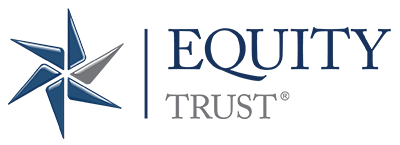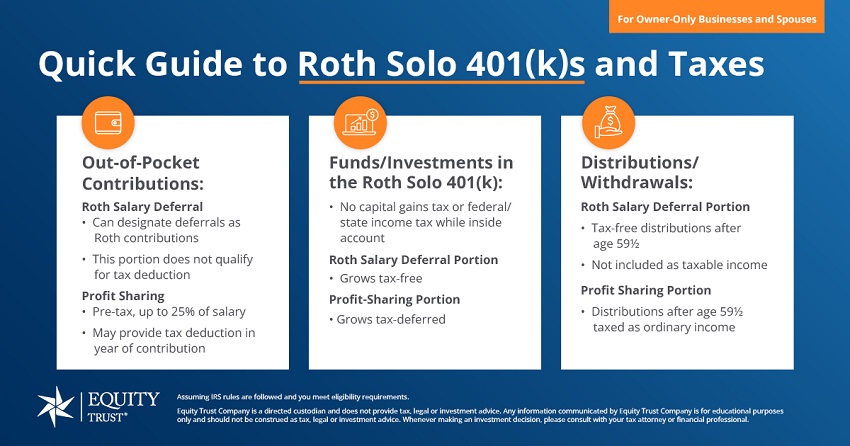What is a Roth Solo 401(k)?
A Roth Solo 401(k) (also known as the Roth Individual 401(k)) is a retirement plan designed for self-employed individuals or small business owners with no full-time employees, except a spouse.
Unlike traditional Solo 401(k)s, contributions to the Roth portion are made with after-tax dollars. This means you won’t get a tax deduction up front, but both your contributions and any earnings grow tax-free, and qualified withdrawals in retirement are also tax-free.
The self-directed Roth Solo 401(k) is available to anyone with a Solo 401(k). It’s a benefit to higher-paid employees and self-employed individuals who may have been excluded from having a Roth IRA because of income limitations.
The Roth Individual 401(k) possesses the same benefits of the Individual 401(k) (higher contribution limits than other accounts), as the tax benefits of the Roth IRA. The contribution limits are the same as the Individual 401(k), but you can designate your contributions through salary deferral as Roth contributions.
Videos
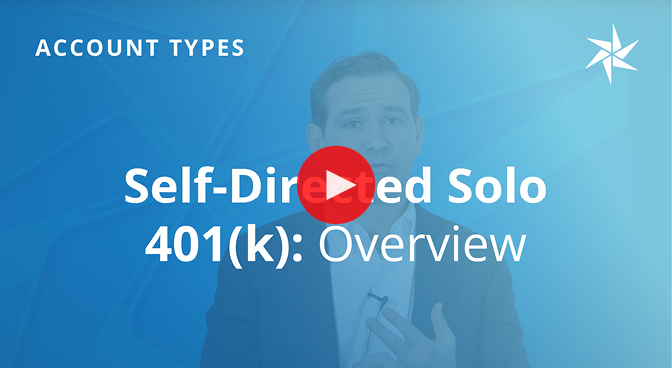
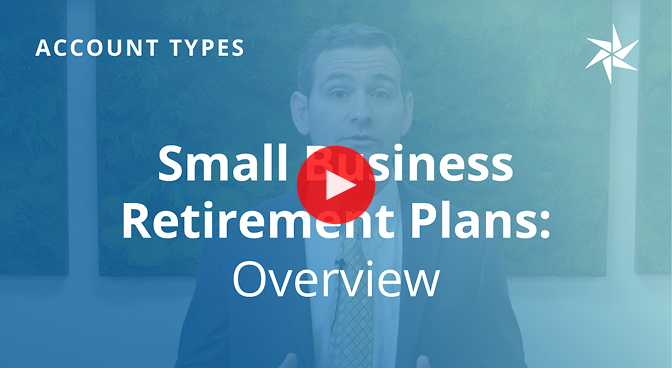
Benefits of a Roth Solo 401(k)
High contribution limits: The Roth Solo 401(k) offers significantly higher contribution limits compared to other retirement accounts, allowing you to contribute more toward your future. This flexibility lets you adjust contributions based on your income and business performance, helping you maximize your retirement savings potential.
No required minimum distributions: Unlike traditional retirement accounts, Roth Solo 401(k) accounts are not subject to RMDs during your lifetime, allowing your investments to continue growing tax-free for as long as you want.
Loan options: With a Roth Solo 401(k), you can borrow up to 50% of your account balance or $50,000, whichever is less. Loans must be repaid within five years, offering financial flexibility without taxes or penalties if repaid on time.
Spousal participation: If your spouse works in your business, they can also open and contribute to a Roth Solo 401(k), effectively doubling the contribution potential for your household.
Explore the Equity Roth Solo 401(k) Solution
Looking to take greater control of your retirement while maximizing tax-free growth potential? The Equity Roth Solo 401(k) solution is designed for self-employed individuals who want to invest beyond traditional options while benefiting from tax-free distributions in retirement.
Our all-in-one platform makes it easier to:
- Establish, track, and maintain your plan
- Contribute directly to a Roth account
- Convert pre-tax and post-tax contributions to Roth
- Directly control funds for real-time investing
- Automatically generate IRS forms like 5500-EZ and 1099-R
Unlike other solutions, we offer more than just plan documents. We give you an integrated platform built for tax-smart, self-directed retirement planning.
Interested in alternative investments but don’t know where to start?
No problem. We make it easy to locate potential investments.
Available through our online account management system, myEQUITY, the WealthBridge portal provides a secure, direct connection to alternative asset investment platforms.
Discover WealthbridgeOur online marketplace introduces you to dozens of asset providers across various investment types including turnkey real estate, private equity, cryptocurrency, precious metals, and more.
Visit Investment DistrictRoth Solo 401(k) Contribution Limits
The IRS sets annual contribution limits for a Roth Solo 401(k), allowing for contributions up to a fixed dollar amount or 25% of your compensation for the pre-tax profit-sharing portion. There is also a maximum compensation limit that can be considered when calculating contributions.
See the current year’s contribution limits.
Roth Solo 401(k) Contribution Limits and Deadlines
| 2025 | 2024 | |
| Standard Contribution Limit – Employee Salary-Deferral Contribution |
$23,500 | $23,000 |
| Standard Contribution Limit – Employee Salary-Deferral & Employer Profit-Sharing Contributions * |
$70,000 | $69,000 |
| Catch-up Contribution Limit (Age 50 and older) – Employee Salary-Deferral Contribution |
$31,500 | $30,500 |
| Catch-Up Contribution Limit (Age 50 and older) – Employee Salary-Deferral & Employer Profit-Sharing Contributions * |
$77,500 | $76,500 |
| Super Catch-Up Contribution Limit (Age 60 – 63) Beginning in 2025 – Employee Salary-Deferral |
$34,750 | N/A |
| Super Catch-Up Contribution Limit (Age 60 – 63) Beginning in 2025 – Employee Salary-Deferral & Employer Profit-Sharing Contributions * |
$81,250 | N/A |
| Contribution Deadline | 12/31/2025 | 12/31/2024 |
* The annual limit for the Employer Profit-Sharing Contribution is 25% of the employee’s pay (20% of pay for a self-employed person)
| 2024 | |
| Standard Contribution Limit – Employee Salary-Deferral Contribution |
$23,000 |
| Standard Contribution Limit – Employee Salary-Deferral & Employer Profit-Sharing Contributions * |
$69,000 |
| Catch-up Contribution Limit (Age 50 and older) – Employee Salary-Deferral Contribution |
$30,500 |
| Catch-Up Contribution Limit (Age 50 and older) – Employee Salary-Deferral & Employer Profit-Sharing Contributions * |
$76,500 |
| Contribution Deadline | 12/31/2024 |
* The annual limit for the Employer Profit-Sharing Contribution is 25% of the employee’s pay (20% of pay for a self-employed person)
Roth Solo 401(k) Eligibility Requirements
Like the Individual 401(k), the Roth Solo 401(k) is for incorporated and unincorporated businesses, sole proprietorships, partnerships, and corporations. The only requirement for contributions to this plan is that you receive a salary or wage.
The business entity must have no additional employees other than the spouse of the proprietor—or, in the case of a partnership, the only employees must be self-employed partners and their spouses. An Individual 401(k) plan must be the only arrangement maintained by the business that is not included as part of a controlled group under federal tax law.
The deadline for establishing an Individual 401(k) plan is the last day of your business’s tax year (December 31, for a calendar tax year). However, if your business is incorporated, you may want to establish an Individual 401(k) plan early in the tax year to make employee salary deferrals based on the Form W-2 income throughout the year.
This is necessary because you may not defer on compensation that is paid to you from your corporation before you establish the Individual 401(k) plan.
Roth Solo 401(k) Account Rules
Required holding period: To qualify for tax-free distributions of both contributions and earnings, the Roth Solo 401(k) must be held for at least five years. This rule applies even if you are already over 59½.
Qualified distributions: Distributions from the Roth Solo 401(k) are tax-free if you are 59½ or older and have met the five-year holding period. Withdrawals before 59½ or without meeting the holding period may result in taxes and penalties on the earnings portion.
Employer contributions: Employer contributions must be made on a pre-tax basis and cannot be designated as Roth contributions. These contributions will be taxed as ordinary income when withdrawn.
Rollover restrictions: You can roll over a Roth Solo 401(k) into a Roth IRA upon retirement or leaving the business. However, certain rules apply to ensure tax-free treatment, such as the five-year holding period and distribution timing.
Roth Solo 401(k) and Taxes
Contributions to a Roth Solo 401(k) are made with after-tax dollars, meaning they don’t reduce your taxable income in the year they’re made. However, both contributions and any earnings grow tax-free. When you reach retirement age, qualified withdrawals—including contributions and earnings—are completely tax-free.
Employer contributions are made pre-tax and are taxed upon withdrawal. Non-qualified withdrawals from employer contributions or earnings before age 59½ may incur taxes and a 10% early withdrawal penalty.
In addition to after-tax Roth contributions, a Roth Solo 401(k) allows for pre-tax profit-sharing contributions. As an employer, you can contribute up to 25% of your compensation toward the pre-tax portion of the plan.
These contributions may provide a valuable tax deduction in the year they are made, reducing your taxable income. While these profit-sharing contributions grow tax-deferred, they will be subject to taxes when withdrawn during retirement.
Roth Solo 401(k) vs. Solo 401(k) Comparison
When planning for retirement, self-employed individuals and small business owners often choose between a Solo 401(k) and a Roth Solo 401(k). Each option has distinct tax benefits and withdrawal rules, making them valuable tools depending on your goals.
Here’s a breakdown of the key differences between the two options. Keep in mind: with the Equity Solo 401(k) solution, you can take advantage of both options, within the same plan.
| Roth Solo 401(k) | Traditional Solo 401(k) | |
| Tax Advantages | Contributions are after-tax and withdrawals are tax-free in retirement | Contributions are tax-deductible, and withdrawals are taxed in retirement |
| Contribution | Allows both employee and employer pre-tax contributions, but employee deferrals are after-tax; employer contributions are pre-tax | Allows both employee and employer pre-tax contributions |
| Required Minimum Distributions | No RMDs | RMDs start at age 73 |
| Profit-Sharing Contributions | Employer contributions are pre-tax and taxed when withdrawn | Up to 25% of compensation is tax-deductible for the business |
| Penalties for Early Withdrawal | Earnings will be taxed as income plus 10% penalty on earnings | Earnings will be taxed as income plus 10% penalty on earnings |
| Tax Treatment at Withdrawals | Withdrawals are tax-free if requirements are met | Withdrawals are taxed as ordinary income in retirement |
| Eligibility | Self-employed individuals or business owners with no employees, except a spouse | Self-employed individuals or business owners with no employees, except a spouse |
| Roth Solo 401(k) | |
| Tax Advantages | Contributions are after-tax and withdrawals are tax-free in retirement |
| Contribution | Allows both employee and employer pre-tax contributions, but employee deferrals are after-tax; employer contributions are pre-tax |
| Required Minimum Withdrawals | No RMDs |
| Profit-Sharing Contributions | Employer contributions are pre-tax and taxed when withdrawn |
| Penalties for Early Withdrawal | Earnings will be taxed as income plus 10% penalty on earnings |
| Tax Treatment at Withdrawals | Withdrawals are tax-free if requirements are met |
| Eligibility | Self-employed individuals or business owners with no employees, except a spouse |
Getting Started with a Roth Solo 401(k)
Here are the steps to get started with your Roth Solo 401(k):
Check your eligibility
You must have self-employment income and no full-time employees (other than yourself or your spouse).
Get your Employer Identification Numbers (EINs)
You’ll need one for your business and one for your Solo 401(k) plan.
Apply online
Have your EINs, business start date, and ID ready. Complete the application and start your subscription.
Open a plan bank account
Use our integrated bank or another provider—just make sure the bank account is titled to your Solo 401(k).
Fund your plan and begin investing
Contribute directly or roll over eligible funds. Start investing from your plan account with full control.
FAQs
What’s the difference between a Roth and Traditional Solo 401(k)?
With a Roth Solo 401(k), your contributions are made after-tax and qualified withdrawals in retirement are tax-free. Unlike Roth IRAs, there are no income limits to contribute.
Can I open a Roth Solo 401(k) on my own?
Yes. If you’re self-employed with no full-time employees (other than a spouse), you can open a Roth Solo 401(k). Our platform allows you to establish and manage your Roth Solo 401(k) with tools for tracking contributions, assets and more.
How to open a Roth Solo 401(k)?
Once you’ve confirmed you’re eligible, you can open a Roth Solo 401(k) by establishing your plan through our online platform, setting up a dedicated bank account, and funding the account.
Can I have a Roth IRA and a Roth Solo 401(k)?
Yes, you can have both a Roth IRA and a Roth Solo 401(k). However, the contribution limits for each account are separate, so contributing to one doesn’t impact the contribution limit for the other. This allows you to maximize your tax-advantaged retirement savings across both accounts.
Can I roll over funds from another retirement account into a Roth Solo 401(k)?
Yes. You can roll over Roth 401(k) or Roth 403(b) funds and convert pre-tax or post-tax funds into Roth using our built-in conversion tool. Traditional 401(k) funds can also be rolled over and converted to Roth funds using our built-in conversion tool. Note that taxes will apply at the time of conversion.
Are there income limits for contributing to a Roth Solo 401(k)?
No, unlike a Roth IRA, there are no income limits for contributing to a Roth Solo 401(k). This makes it an attractive option for high-income earners who want tax-free withdrawals in retirement.
Are there RMDs for a Roth Solo 401(k)?
Unlike the traditional Solo 401(k), there are no required minimum distributions with a Roth Solo 401(k).
Qualified withdrawals from a Roth Solo 401(k) are tax-free if you are at least 59½ and have had the account for at least five years. If you withdraw funds before meeting these criteria, you may be subject to taxes and penalties on the earnings portion.
How do withdrawals work with a Roth Solo 401(k)?
Qualified withdrawals from a Roth Solo 401(k) are tax-free if you are at least 59½ and have had the account for at least five years. If you withdraw funds before meeting these criteria, you may be subject to taxes and penalties on the earnings portion.
Can my spouse participate in my Roth Solo 401(k)?
Yes, if your spouse works in your business, they can also open and contribute to a Roth Solo 401(k), effectively doubling your household’s retirement savings potential.
Does your Solo 401(k) platform track Roth vs. pre-tax contributions?
Yes. The Equity platform automatically separates and tracks contribution types and maintains precise records for IRS reporting.
Can I switch from another provider to your Roth Solo 401(k)?
Yes. You can transfer an existing Solo 401(k) or Roth Solo 401(k) into our system.
Can I invest in alternative assets using a Roth Solo 401(k)?
Absolutely. As long as the asset isn’t prohibited by the IRS, you can invest in private equity, real estate, crypto, and more—directly from your Roth Solo 401(k).
Equity Specialty Services, LLC (“ESS”) has partnered with SEPira(k) to offer you the Equity Solo 401(k) solution to establish and manage your Solo 401(k). By combining SEPira(k)’s technology platform with ESS’s customer support, you will have the tools to manage your Solo 401(k) seamlessly.
Equity Specialty Services, LLC is a services company which offers services such as acting as a solo 401k solution provider, offering document preparation and referral loans services and other services to assist an investor with his/her investments. Equity Specialty Services does not offer investment, tax, or legal advice, and no services offered by us should be considered to replace the need for qualified investment, tax, and legal professionals. It is for education only. Please consult your legal or financial advisor before making any financial decisions. Equity Specialty Services may receive or give referral fees from third party vendors for services it offers to investors.


